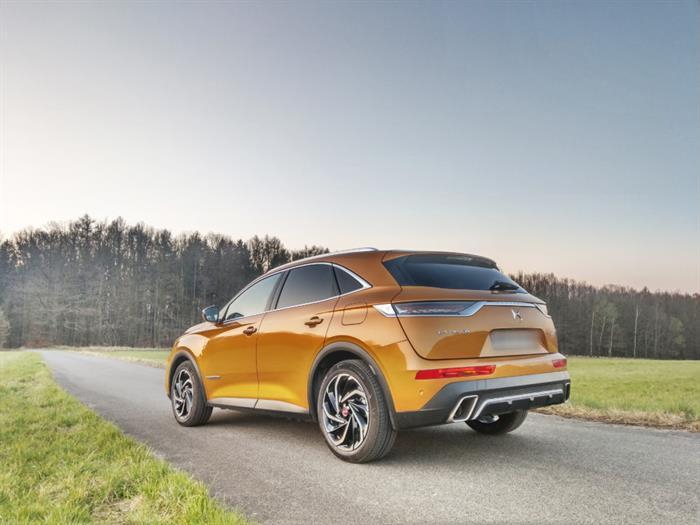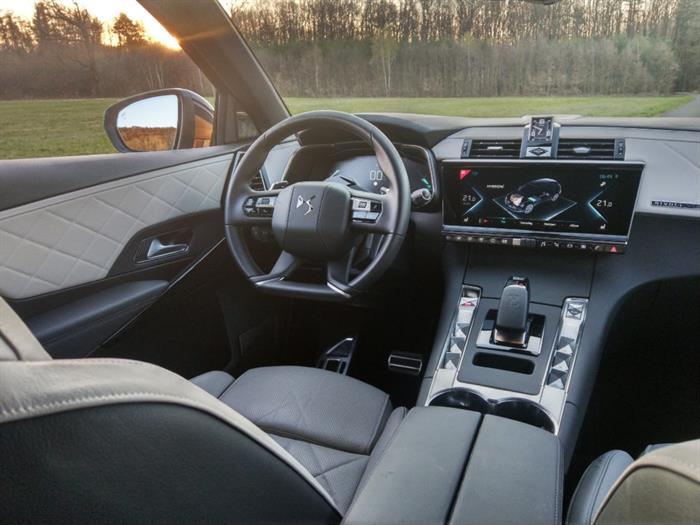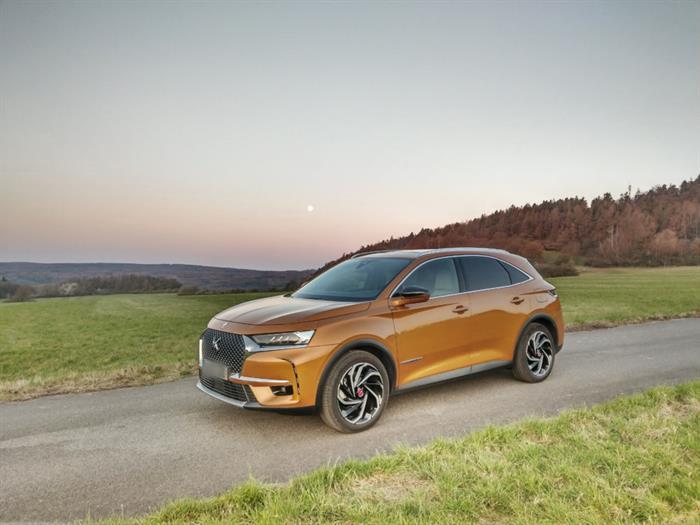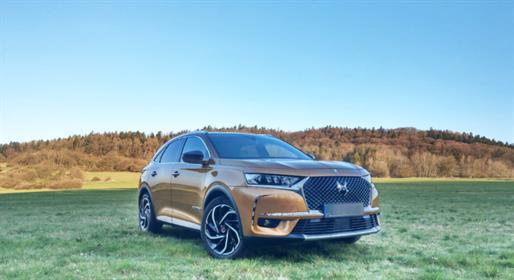The DS 7 Crossback is the first car with which the DS car company presented itself as an independent brand. Its currently offered cars, within the PSA concern, come with a large dose of originality, imagination and an effort to attack the premium class.
The DS 7 Crossback model has already become quite familiar to us, in the past we have tested it both with a 16-liter gasoline engine and with a two-liter diesel engine .
Now, however, we have a much more interesting piece, we received its new plug-in hybrid design with a pair of electric motors and 300 horses of combined power for the editorial test.

Exterior
The DS 7 Crossback is a car offering quite classic basic shapes, but with a considerable amount of robustness. What makes this model special is the great attention to detail. Mostly in the treatment of the front and rear of the car.
The front part is dominated by a voluminous mask with very fine detailing and prominent chrome around its perimeter. We also have the front headlights, which with their rotating modules can put on a very impressive show, or the daytime running lights line, which with its typical light signature clearly indicates which stable it comes from.
The rear section impresses with a continuous chrome line, which incorporates horizontal taillights with a spatial effect. Again, their treatise carries great detail. The lower part of the rear is then dominated by two full-sized, voluminous and vertically oriented exhaust tips.
Its plug-in hybrid belonging to the car is then clearly visible from the plaque on the front hood, from the inscription on the trunk lid, or from the specifically shaped wheel discs.

Interior
The interior of the currently tested plug-in hybrid car does not differ significantly from the "classic", previously tested versions.
The interior of the DS 7 Crossback will therefore continue to impress you with its richness and high-quality workmanship. The continuous dashboard is effectively fused with the massive central panel, which is equipped with an automatic transmission selector (in the tested version supplemented with the "B" position) and individual controls for the electric windows, parking brake or drive mode selector. Only the on-board infotainment display "disrupts" the continuity of the dashboard. With its twelve inches, it creates a relatively significant dominant feature of the entire dashboard. In addition, it has very pleasant graphics and, thanks to the bottom bar with quick selection, also completely logical controls.
For me, the weak point of the interior of DS cars is the graphics of the fully digital display in the instrument compartment in front of the driver. The ever-present motif of the diamond is prescribed even in its treatise, unfortunately it makes it quite confusing and too playful for my taste.
I have to praise the spaciousness of the entire interior as well as the spaciousness of the seats themselves. Those in the front positions offer the option of massage or cooling, while the rear positions have the option of electrically folding backrests.
The interior of the DS 7 must not be missing the BRM R 180 rotating analog clock, which is hidden in the dashboard and turns into the cabin space after each start of the car, following the example of the rotating headlight modules. The start button itself is quite unconventionally located just below this clock, i.e. in the middle of the dashboard.
The plug-in hybrid version therefore brought minimal changes to the interior of the car. The automatic transmission selector has received an additional position for recuperating electrical energy, as well as the E-Tense logo. Furthermore, a new button has appeared in the bar below the on-board infotainment display that calls up information on the flow of electricity or the eSave function.
The body of the car itself anticipated the future installation of this type of drive, the plug-in hybrid thus does not have a negative impact on the size of the luggage compartment, the presence of batteries limited only the size of the fuel tank.

Plug-in hybrid motorization and driving impressions
The DS 7 has been available with both petrol and diesel engines since its launch. In both cases, they are well-known corporate power units. In the case of gasoline, it is a turbocharged 16-liter PureTech, diesel is represented by a turbocharged 15-liter and two-liter BlueHdi.
The new plug-in hybrid model then comes with this scheme. The basis of the drivetrain is the well-known and already mentioned turbocharged 16-liter PureTech gasoline engine, which here has an output of 147 kW. It also cooperates with an 81 kW electric motor within the front axle. The performance of the announced engine and electric motor is then transmitted to the front axle thanks to an eight-speed automatic transmission. This scheme is also used by the PSA concern for its other plug-in hybrid cars with only front axle drive.
But the DS 7 is a four-wheeler (which does not have a "cardan drive"), so a second electric motor comes into action, which is equipped with the rear axle. This electric motor produces an output of 83 kW, bringing the total combined power of the plug-in hybrid DS 7 to a very respectable value of 220 kW (300 hp) and 520 Nm of torque.
The DS 7 Crossback E-Tense offers 4 selectable driving modes. These are classic hybrid mode, 100% electric mode, sports mode and 4×4 mode.
In practice, this means that the DS 7 activates (not starts) in electric mode every time. The following distance traveled therefore usually takes place, of course depending on the current state of charge of the battery, or the current need for power, in purely electric mode. In this mode, the rear electric motor only takes care of the drive. The manufacturer's data claims that with a fully charged battery, the car can travel up to 58 km purely on electric energy. During the weekly test, I reached a value slightly below 40 km (of course, everything depends on the parameters of the route, driving style, etc.).
The car is equipped with a battery with a capacity of 13.2 kWh. Charging it from a standard 230 V household socket takes between 7-8 hours, and from a public charging station with an output of 7.4 kW, you can recharge the car in 1 hour 45 minutes. Unfortunately, the E-Tense cannot be charged with a fast charger.
As with other "plugins", this car also has a simple rule of course, ideally it should be charged as soon as it is not in motion. The DS 7 Crossback E-Tense offers a very comfortable and quiet ride in electric mode. In sports mode with sufficient battery capacity, a very dynamic ride. Thanks to its proportions, it is not a "turning" specialist, but its flexible acceleration is quite impressive. The presence of the second electric motor, 300 horsepower and 520 Nm of torque, is easy to recognize.
In the case of regular recharging, you will reach very friendly car consumption values, which always depend on the state of charge of the batteries. With the car, I ranged from 2.0 l/100km to 8.5 l/100km.
I must also mention the DS ACTIVE SCAN SUSPENSION system, in which there is a certain cooperation between the front camera and the adaptive chassis. The camera scans the surface in front of the car and the adaptive chassis is able to react to the current surface thanks to the available information. The entire system then works up to a speed of 130 km/h and greatly contributes to driving comfort.

In conclusion
The basic DS 7 Crossback is available from CZK 895,000 including VAT, with a turbocharged 15-litre diesel engine, manual six-cylinder engine and PERFORMANCE LINE equipment.
The plug-in hybrid version is then available from CZK 1,395,000 including VAT. This is SO CHIC gear here. The tested GRAND CHIC equipment starts at CZK 1,555,000 including VAT. The specifically tested car, after adding up all additional equipment (DS CONNECTED PILOT, DS NIGHT VISION, FOCAL Electra HiFi system, front seat ventilation or panoramic sunroof) climbed to a total astronomical sum of CZK 1,781,500 including VAT.
The price of the car already includes a 5-year / 100,000 km warranty as well as a FreeDrive service contract for the same range. This includes all mandatory service, including service work and replacement of worn parts.
DS cars currently bring us a clear, distinctive style and a great sense of detail, all under the guidance of the PSA concern. The same, of course, also applies to its representative of the SUV category, i.e. the DS 7 Crossback model. In addition, the tested plug-in hybrid version of the E-Tense will also offer economical operation and, thanks to the concept with a pair of electric motors, it can also be quite dynamic. Its only downside for me is the higher purchase price.
Source: Author's text
Image source: Author's own photos





























